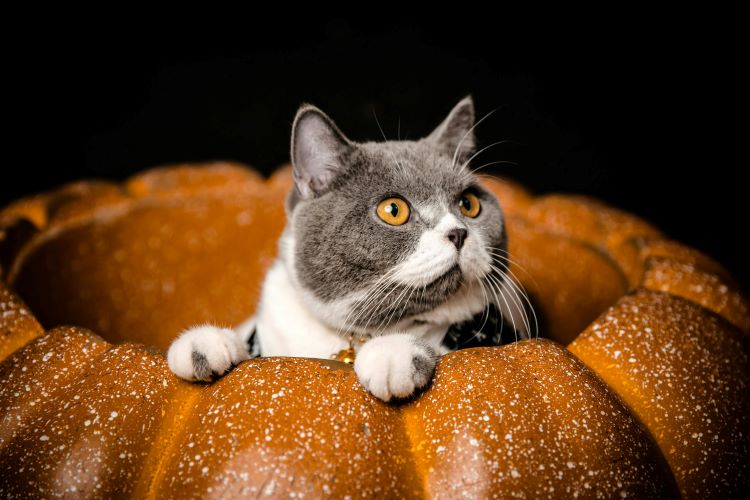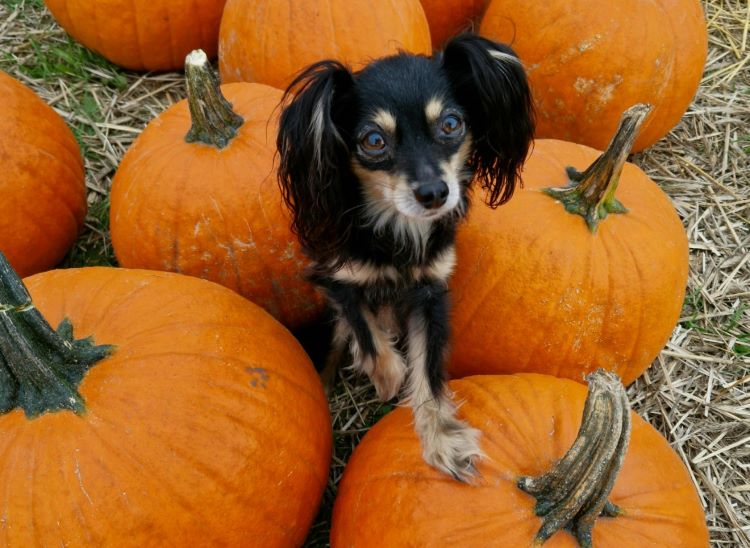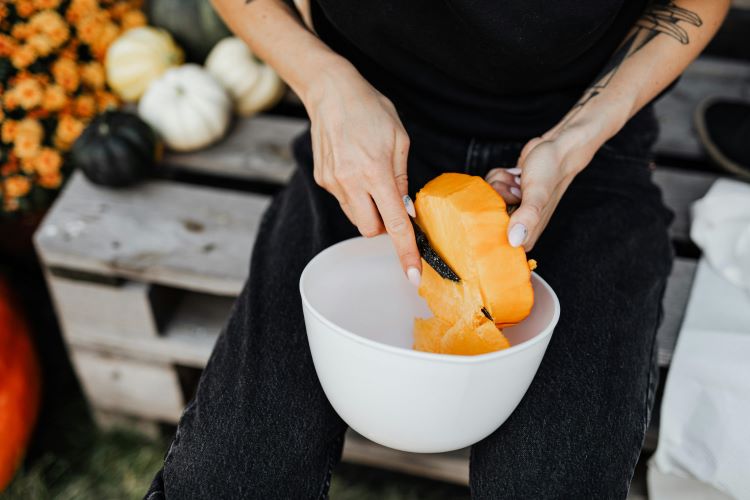Ready to help treat your pet to a healthy life?
Is Pumpkin Good for Dogs & Cats? How to Serve it Safely to Pets
By : Brianna Gunter | Published Oct 15, 2024

Dogs and cats are famously carnivorous and need animal-based protein to survive. But from time to time, it’s normal to want to change up their diet and incorporate non-meat items both for health benefits and variety. One of the most common food items that often comes in these situations is pumpkin. Perhaps you’ve seen pet food with pumpkin in it or have just heard anecdotally that it’s fine, if not recommended, for pets to eat.
Of course, as a responsible and inquisitive pet owner, you know that pet food varies in quality, and you can’t believe everything you see and hear. So, how can you safely serve pumpkin to pets? More importantly, is it actually beneficial for dogs and cats?
Pumpkin health benefits
The short answer is, yes, you can feed pets pumpkin. However, you should only do so in moderation and under the right circumstances. We’ll get into safety tips you should know regarding this in just a bit, but first you should know what the potential benefits of pumpkin for pets are.
It’s important to note that a lot of the purported benefits are not based on real studies but rather anecdotal evidence. While pumpkin is often touted as a “superfood,” it is not an essential part of your pet’s diet and will not cure any illnesses. Giving your pet too much of it can likewise backfire and cause harm due to the high fiber content. Pumpkin is also unnecessary for most pets who are already having their nutritional needs met with high-quality daily food designed for their specific life stage.
That said, there are circumstances where veterinarians may recommend pumpkin in moderation for certain health benefits.
1. Gastrointestinal health
The most common reason vets suggest giving pets pumpkin is the possibility for it to help with digestive issues. Dogs and cats suffering from constipation or diarrhea can benefit here:
- For constipation — Fiber adds bulk to the stool, helping it pass more easily. This is especially helpful for older pets, who may experience slow digestion and more frequent constipation.
- For diarrhea — Surprisingly, pumpkin can also help firm up stools. Its soluble fiber content can absorb excess water in the digestive tract.
- For anal glands — pumpkin is often recommended to see if it helps with pets that have issues with full anal glands. The added bulk may help with naturally expressing them on their own when pets defecate.
2. Weight management
For overweight pets, pumpkin can act as a low-calorie supplement that adds volume to their food without adding a lot of extra calories. It can help make your pal feel fuller for longer, reducing the likelihood of them overeating.
If your pet could stand to lose some weight, however, be sure to not rely on pumpkin alone. Work with your veterinarian to develop a treatment plan that addresses both diet and exercise.

3. Added nutrients
If you’re like most pet parents and feed your furry friend the same thing every day, they may not be getting vitamins and minerals that could benefit them. If you’re concerned about your pet’s diet and health, it’s always a good idea to consult with their veterinarian. However, pumpkin is known to contain certain nutrients that may benefit canine and feline diets lacking in them:
- Fiber*
- Vitamins A, C, and E
- Potassium
- Iron
- Beta-carotene (an antioxidant that converts into vitamin A)
*Pumpkin is often praised as a source of fiber for pets. However, it contains both soluble and insoluble fiber that can actually limit its effectiveness here. If your pet’s diet has been determined to be lacking in fiber, a better option is to talk with your veterinarian about their specific needs. Depending on what kinds of fiber your pet actually needs, your vet will be able to work with you on a therapeutic diet that addresses this more successfully.
4. Hairball control (for cats)
Cats frequently suffer from hairballs due to their grooming habits. The extra fiber in pumpkin can help reduce the formation of hairballs by promoting regular bowel movements. This can help ensure that the ingested fur passes smoothly through the digestive tract rather than forming hairballs.
How to serve pumpkin safely to pets
This should come as no surprise, but pets can’t consume pumpkin in all the same ways humans can. While we enjoy our pumpkin breads, fancy lattes, and pumpkin-spice everything in fall, the only safe way to serve pumpkin to dogs and cats is plain and cooked.
But before you try that, give your veterinarian a call. This is crucial before making any changes to your pet’s diet. Your vet can provide guidance on its appropriateness and recommend proper dosage. While pumpkin can be beneficial, it may not be suitable for all pets.
Keep in mind that while pumpkin can be helpful in the right portions, it should never replace a balanced, nutrient-dense pet food.
Pet-safe portions
For dogs, always start small with no more than a tablespoon of cooked, plain pumpkin at a time. Cats should meanwhile be started with no more than a teaspoon. To keep things simple, consider mashing the pumpkin up or using plain, unsweetened pumpkin puree. Never use pumpkin pie filling as this contains added sugar and spices. You should also watch for and avoid any canned pumpkin with added salt.
If your pet tolerates the pumpkin well and seems to enjoy it (and you’ve gotten the go-ahead from your vet), you can try slightly increasing the portions if your vet recommends doing so. You can also mix small portions of pumpkin into their regular pet food. While pumpkin is generally considered safe for pet consumption, stop right away if they experience any gastrointestinal upset or other adverse reactions.

Differences between dogs and cats
While both dogs and cats can both benefit from consuming pumpkin, they do have some digestive differences worth considering. To start, dogs are able to eat a broader range of food and can be considered omnivorous. They are most healthy when eating a meat-based diet balanced out with certain fruits and vegetables (by the way for those wondering, pumpkins are technically a fruit).
Cats meanwhile are obligate carnivores and must rely on an almost entirely meat-based diet. They can still process pumpkin from time to time and may benefit from it, but they should be served it more sparingly than dogs. Especially if you’ve never served your cat pumpkin before, be sure to consult with their veterinarian beforehand.
When to avoid giving pets pumpkin
Be aware of potential risks and allergies. Some pets may have sensitivities to pumpkin that could cause stomach upset or even allergic reactions. For dogs and cats with any underlying conditions — especially those maintained on special/prescription diets — always consult with your DVM before adding anything extra to their diet.”
When you do feed your pet pumpkin, always monitor for adverse reactions like diarrhea, vomiting, or changes in appetite. If you notice any symptoms, discontinue the pumpkin and talk with your veterinarian.
Shopping for pet food? When you see pet food with pumpkin in them, be sure to read the other ingredients too! While many are healthy and contain a variety of nutrients for your pet, some may contain fillers or excess grains that may work against your pal’s health.
Prioritize your pet’s health further by signing them up for a good pet insurance plan.
